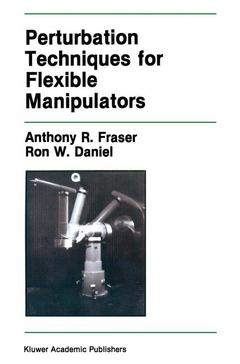Perturbation Techniques for Flexible Manipulators, Softcover reprint of the original 1st ed. 1991 The Springer International Series in Engineering and Computer Science Series, Vol. 138
Langue : Anglais
Auteurs : Fraser Anthony R., Daniel Ron W.

A manipulator, or 'robot', consists of a series of bodies (links) connected by joints to form a spatial mechanism. Usually the links are connected serially to form an open chain. The joints are either revolute (rotary) or prismatic (telescopic), various combinations of the two giving a wide va riety of possible configurations. Motive power is provided by pneumatic, hydraulic or electrical actuation of the joints. The robot arm is distinguished from other active spatial mechanisms by its reprogrammability. Therefore, the controller is integral to any de scription of the arm. In contrast with many other controlled processes (e. g. batch reactors), it is possible to model the dynamics of a ma nipulator very accurately. Unfortunately, for practical arm designs, the resulting models are complex and a considerable amount of research ef fort has gone into improving their numerical efficiency with a view to real time solution [32,41,51,61,77,87,91]. In recent years, improvements in electric motor technology coupled with new designs, such as direct-drive arms, have led to a rapid increase in the speed and load-carrying capabilities of manipulators. However, this has meant that the flexibility of the nominally rigid links has become increasingly significant. Present generation manipulators are limited to a load-carrying capacity of typically 5-10% of their own weight by the requirement of rigidity. For example, the Cincinatti-Milicron T3R3 robot weighs more than 1800 kg but has a maximum payload capacity of 23 kg.
1 Introduction.- 1.1 Objectives.- 1.2 Book outline.- 2 Present trends in the dynamics and control of flexible manipulators.- 2.1 Introduction.- 2.2 Space Structures.- 2.3 Dynamics of flexible manipulators.- 2.4 Control of flexible manipulators.- 2.5 Conclusions.- 3 Dynamic model of a single-link flexible manipulator.- 3.1 Introduction.- 3.2 Analytic model of a single-link arm.- 3.3 Dynamic model based on natural modes.- 3.4 Dynamic models based on assumed modes.- 3.5 Models for control design.- 3.6 Conclusions.- 4 An experimental single-link flexible arm.- 4.1 Introduction.- 4.2 Experimental apparatus.- 4.3 Experimental identification of the system model.- 4.4 Verification of the arm model.- 4.5 Conclusions.- 5 Control design for the single-link arm.- 5.1 Introduction.- 5.2 Digital control design.- 5.3 Experimental flexible arm control.- 5.4 Conclusions.- 6 Multi-link flexible arm dynamics.- 6.1 Introduction.- 6.2 Dynamic model of a planar two-link flexible arm.- 6.3 Linearisation of the dynamic model.- 6.4 Properties of the linearised model.- 6.5 Variation of the linearised model with loading and configuration.- 6.6 Gravitational effects.- 6.7 Control of multi-link manipulators.- 6.8 Conclusions.- 7 A perturbation approach to changing dynamics.- 7.1 Introduction.- 7.2 Canonical perturbation theory.- 7.3 Extension of canonical perturbation theory to flexible systems.- 7.4 Perturbation analysis based on orthogonality of modes.- 7.5 Assumed modes formulation.- 7.6 Conclusions.- 8 Extended perturbation techniques.- 8.1 Introduction.- 8.2 Extended perturbation analysis.- 8.3 Discrete-time perturbation analysis.- 8.4 Corrective control design.- 8.5 Explicit control correction.- 8.6 Direct update of controller gains.- 8.7 Investigation of corrective control on the two-link arm model.- 8.8 A general perturbation-based control scheme.- 8.9 Conclusions.- 9 Looking to the future - high performance control.- 9.1 Introduction.- 9.2 Controller Design.- 9.3 The Provision of Feedforward.- 9.4 Feedback control.- A Symbols and Nomenclature.- B Experimental determination of arm parameters.- C Modal model of the single-link arm.- D Mass and stiffness terms for the two-link arm.- E Derivation of the assumed modes perturbation analysis.- F Transformation from a state-space to an input/output model.
Date de parution : 10-2012
Ouvrage de 275 p.
15.5x23.5 cm
Mots-clés :
Gravitation; Hub; Motor; Potential; Trend; actuator; adaptive control; complexity; computer; control; electric motor; filtering; model; robot; sensor
© 2024 LAVOISIER S.A.S.



